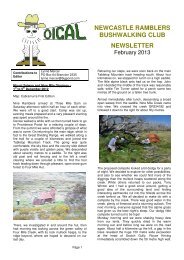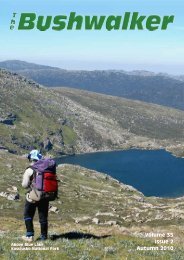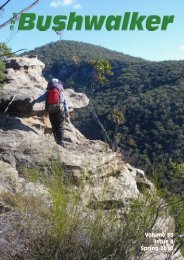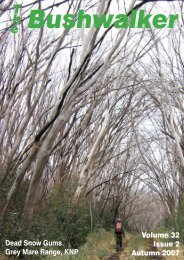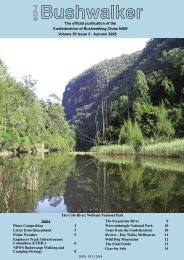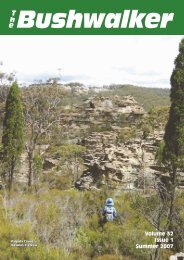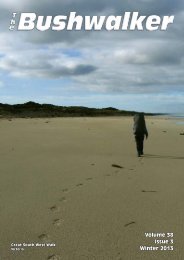Vol 31 No 3 - Confederation of Bushwalking Clubs
Vol 31 No 3 - Confederation of Bushwalking Clubs
Vol 31 No 3 - Confederation of Bushwalking Clubs
Create successful ePaper yourself
Turn your PDF publications into a flip-book with our unique Google optimized e-Paper software.
Walk Safely—Walk with a ClubTread on a path in the Pyrenees and youstep into rich and varied history. Precedingthe walks <strong>of</strong> our Bush Club (Group 3)in June 2006 were not only other groups<strong>of</strong> Australian walkers but also some <strong>of</strong> themost bloody invasions and expeditionaryforces <strong>of</strong> recorded history and religion. Theline up includes Roman, French, Spanishand Moorish Empires, and Catholic, Protestantand Islamic waxings and wanings.The indelible mark <strong>of</strong> mankind is ubiquitousin the Pyrenees.Pilgrims <strong>of</strong> the Chemin de St Jacques deCompostelle, readily identifiable by atleast one scallop shell (Pecten maximus)on their packs or clothing, come to retracethe reputed steps <strong>of</strong> John the Baptist fromvarious commencing points in Francethrough the Pyrenees all the way to thetown <strong>of</strong> Saint John de Compostela on theAtlantic Spanish coast.Real bush? Old growth forest? Naturalenvironment? In some places there aresome remnants <strong>of</strong> what might have beenafter the last ice age. Much <strong>of</strong> the naturalenvironment - serried peaks <strong>of</strong> geologicallyyoung fold mountains and once vastoak and beech forests, has been replacedwith pastures on even the most precipitousslopes. Here goats, sheep, wild horses andcattle share the walking trails with pilgrimsand mountaineers. Above the sky is full <strong>of</strong>flocks <strong>of</strong> griffon vultures and other raptorsmajestically riding the thermals in a constantsearch for the next meal. The occasionaldeer can be surprised in the woodsand rabbits abound.The 2006 European summer season hada torrid start, with the mercury in the midthirties every day. With humidity to matchit was very like midsummer in Sydney.Our base in the rural Payes Basque was anold 18th century farmhouse, named Etxexuria(pronounced Etcherchuria or just“Etchers”). This is located in the LantabatValley near the tiny hamlet <strong>of</strong> St Martin andis about 40 minutes from St Jean Pied dePort. The house has been completely renovatedand is a very comfortable abode. | The BushwalkerGroup organizersand hosts Bob andSue Taffel were atstation and airportto welcome usand provide transportto Etchers.We were a mixedlot – comprisingnon-walkers,moderate walkersand addictedwalkers. It wasBob’s task to runa program that made everybody happy. Hedid a remarkable job.Part <strong>of</strong> the charm <strong>of</strong> the visit was to indulgein the local cuisine. Our cook Sallywas, surprisingly, English but through hercraft as a ‘cuisenaire’ had developed all theskills necessary to ‘cook like a local’. Hermeals used local recipes made with freshingredients bought in the local markets,served with local wines.To the walking. Bob chose fairly localwalks to suit the varying abilities and hightemperatures. Pack walking would havebeen great but was not an option.Our first walk started at Col d’Iphariatze,a saddle at 328 m and a none-too-inspiringplace, bare <strong>of</strong> trees and windswept.Our route was along a ridge, followed bya steep descent into the Pagardeyko Erreka(Erreka = Creek). Humidity was high andwe were grateful for the shade <strong>of</strong> the oaktrees. To the east was the Bois d’Ostabat(Ostabat Forest); this green patch wasmost welcome. To our west was a prettycollection <strong>of</strong> more than a dozen villagesincluding Behaune, Ascombeguey and Orsanco.Most sported a church steeple andprovided serial photograph opportunities.As we swung east onto the GR 65 we encounteredpilgrims. By the time we reachedthe Chapelle de Soyarza there were frequentgroups <strong>of</strong> pilgrims in both directions. Thechapel is surrounded by a planting <strong>of</strong> planetrees, pollarded and cajoled into forming acontinuous, interwoven crown. The effectis dramatic given that the chapel is so elevated.Here we enjoyed morning tea andlimited conversation with pilgrims.Then it was time to head southwest to Harambeltzand the chapel <strong>of</strong> St Nicholas. Thischapel is in a rather sad state, now beingmostly used for storing agricultural items.This was where we had lunch. Some ateoutside but the heat drove three <strong>of</strong> us intothe undercr<strong>of</strong>t area where large squaredbeams now lying on the floor improvisedas seats. Whether it was the location, theheat, the bizarre carved symbols in thestonework or just the right moment but Irecall the conversation being very philosophical,deep and meaningful.As we passed through the south-west section<strong>of</strong> the Bois d’Ostabat, near HarambeltzkoErreka, there were improvisedladders fixed to very large trees that ledto hides, for pigeon shooters. The climbingwas good fun and provided excitementand photo opportunitiesAfter crossing another Erreka – the Ithurriberriako,we joined the Chemin de St.Jacques de Compostelle where time andfeet have lowered the track level by nearlya metre, resulting in a tunnel like effect.Emerging from the tunnel we were soonin the village <strong>of</strong> Ostabat. Here were some17th century buildings still in use includingone that served the function <strong>of</strong> a gited’etape or hostel for travellers: devout pilgrimsor a seasoned bushwalkers.Given the heat we decided that althoughit was Sunday we all merited a drink. Thelocal hostelry was open so in we went.Whilst a beer was popular the most consumeddrink by far was a “Citron Presse”.Made from freshly squeezed lemons, thisdrink is served with an accompanyingjug <strong>of</strong> chilled water and for the weak, abowl <strong>of</strong> sugar. It is truly refreshing and nohangovers. Mind you, one <strong>of</strong> these withoutsugar is about all a guy can handle.Our second walk was to the south west <strong>of</strong>Etchers. We drove through the villages <strong>of</strong>Iholdy, Irissary, Osses and Saint EtiennedeBaigorry and up the steep foothillslopes <strong>of</strong> Aintziaga (872 m) to park at theborder crossing <strong>of</strong> Col d’Ispeguy (672 m).What followed was a truly beautiful walkthrough oak and beech forest along theslopes <strong>of</strong> Olate (935 m)We border crossed several times as wepassed through Nekaitzeko and the Col<strong>Vol</strong><strong>31</strong> Issue 3, Winter 2006



